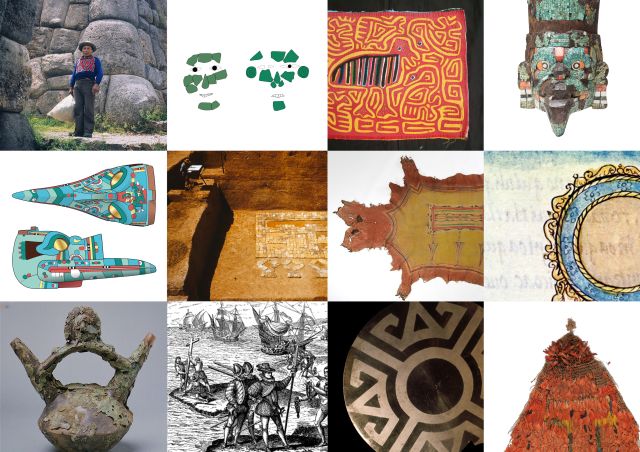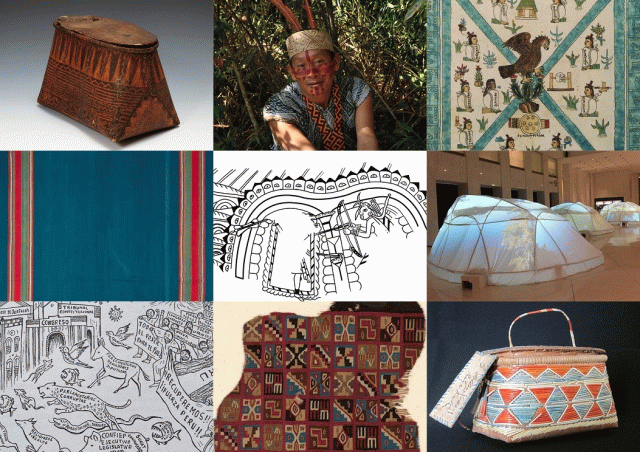Convegno
Between liquid and solid: metals and their transformation
In the framework of the symposium Amerindian Art Histories and Archaeologies: A KHI – UCL Symposium on Material Transformations in the Indigenous Americas
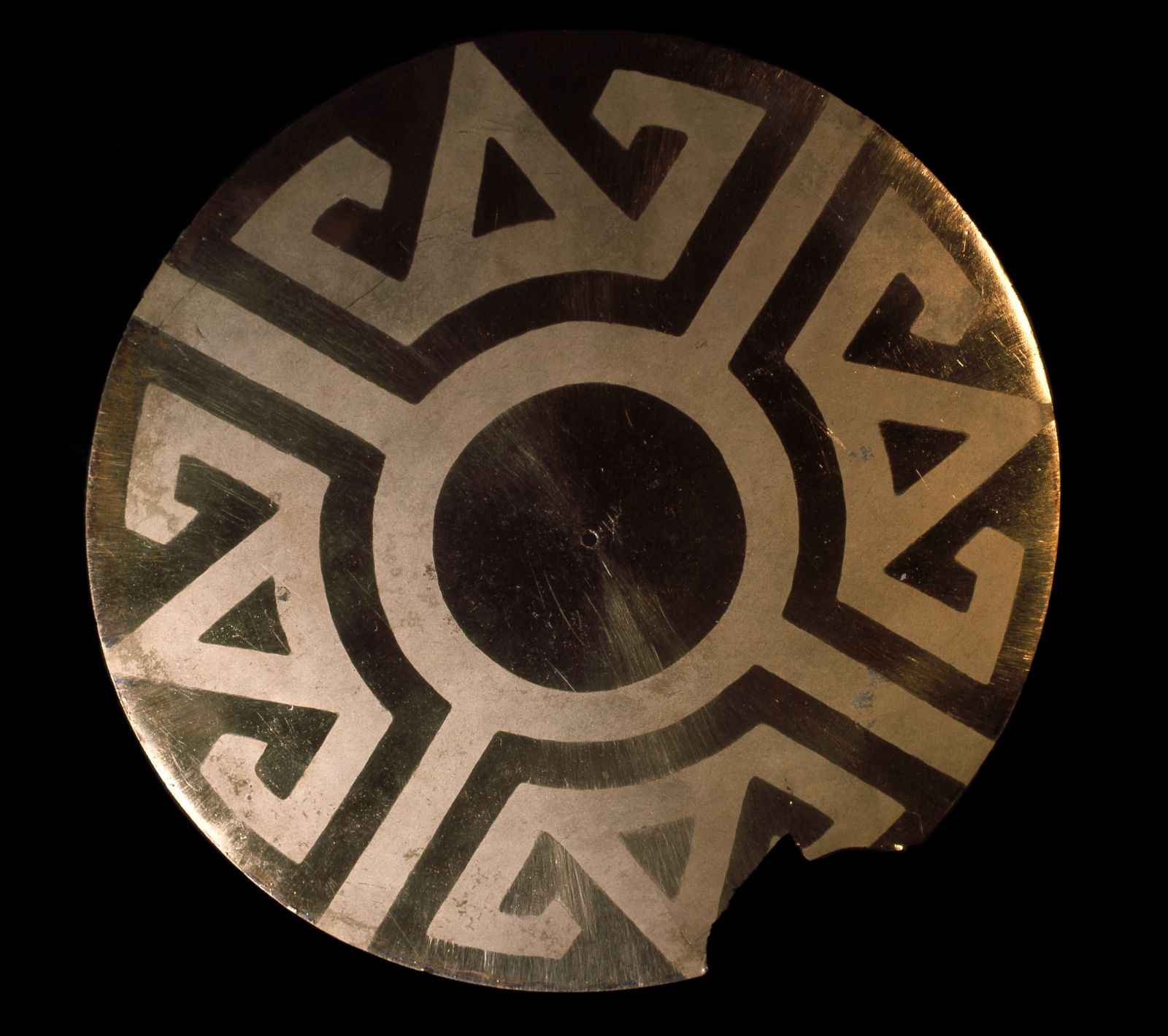
Nariño disk, Southern Colombia (Museo del Oro, Bogotá, Colombia; photo by Clark Manuel Rodríguez).
Speakers
Blanca Maldonado | Unleashing the sacred power of light: the processes for converting ore into metal into shiny objects in the ancient Americas
Abstract
Throughout the ancient Americas, sacred power inhered in many materials and substances, including metals. This worldview is reflected in the properties of metals themselves as well as in the ways they were used. Copper, silver, gold and other metals and alloys were fashioned into adornments, which identified those who wore them with supernatural forces. These objects created a sacred environment in which priests and rulers could enact basic social premises, contributing meaning and structure to these ancient societies. Making shiny objects thus entailed the transformation of the energy of light into substantial forms, by means of technological choices that were connected to a combination of ideology, ritual knowledge and technical skill. Meaning and value were hence granted to the production, exchange, and social and ritual display of brilliant objects. The production of metal and other prestige goods was therefore not only economic, but also political and ideological in nature, often imbedded in specific publicly significant and value-laden acts or events. By their own acts of creation and transformation, smiths and their patrons actively maintained the vital links believed to connect the community and its people with the supernatural energies of the universe. The present contribution deals with the technical choices made by Amerindian metallurgists and metalworkers, as reflections and expressions of cultural values and interests, as well as of environmental and material variables.
Biography
Blanca Maldonado is an archaeologist specialized in ancient metallurgy and production processes. Her research has focused mainly on Mesoamerica and the South-Central Andes. She holds a PhD in Anthropology from the Pennsylvania State University, with specialization in Archaeology, and is currently Full Professor in the Centre for Archaeological Studies at El Colegio de Michoacán, in Mexico. Among Blanca’s numerous publications are the book Tarascan Copper Metallurgy: A Multi-Approach Perspective, the edited volume Cultural Dynamics and Production Strategies in Ancient Western Mexico (with Eduardo Williams), as well as the articles “Traditional Copper Work from Santa Clara del Cobre, Mexico: A Case Study on Technological Change and Persistence” (with P. Castro and P. Tropper), and “De la economía política a la economía de mercado: transiciones tecnológicas, sociales y económicas entre la producción metalurgia prehispánica de Mesoamérica y áreas afines, y la industria minera colonial novohispana” (with P. Castro).
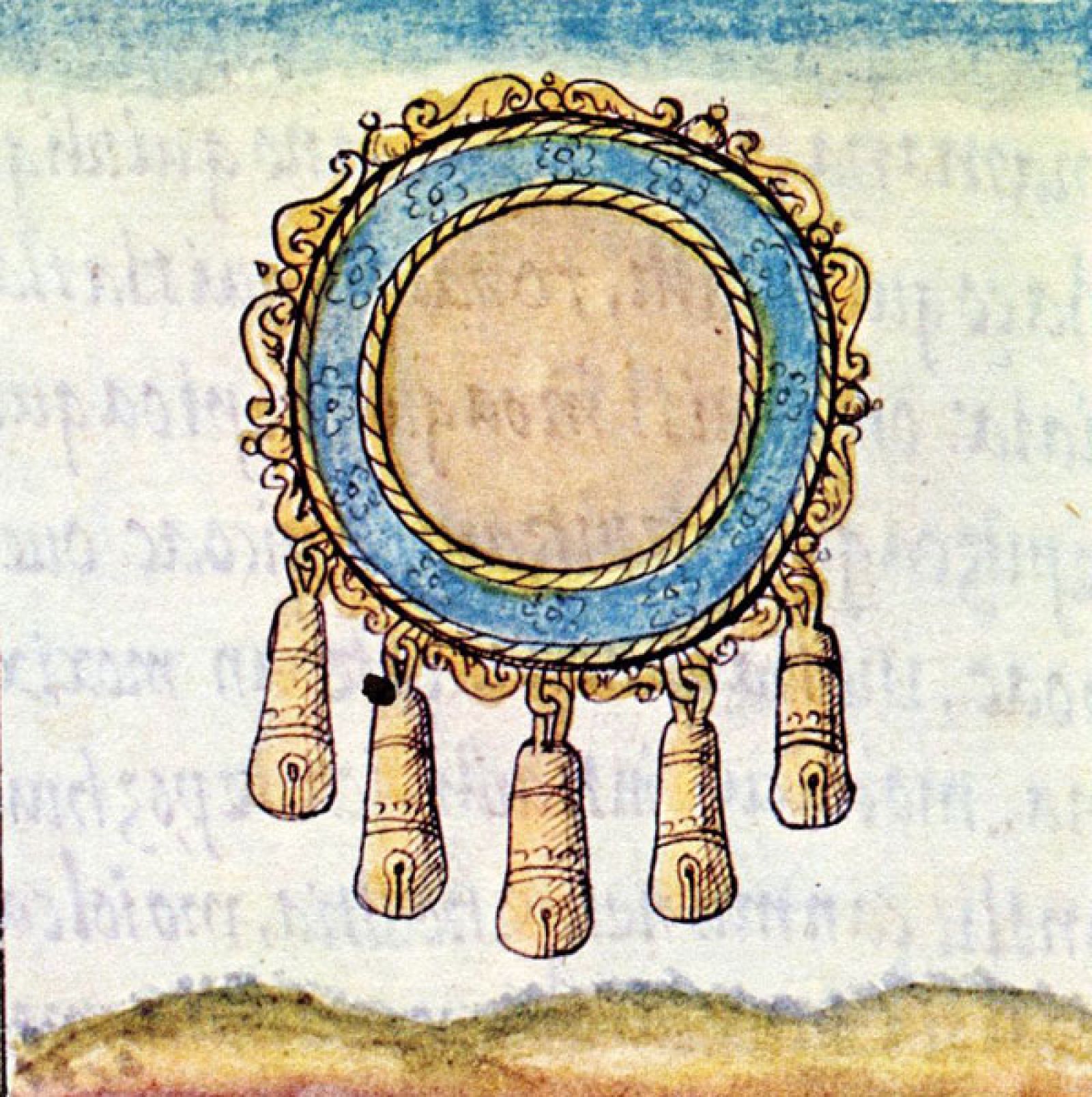
Piece of Aztec jewellery with gold bells (Florentine Codex, Book 9, fol. 50v).
Ana María Falchetti | The essence of transformations: the symbolism of metals and metallurgy in the indigenous Americas
Abstract
Ancient metallurgy in the Americas was produced for more than three thousand years. Indigenous peoples in different areas and periods selected particular metals and techniques to develop their own metallurgical assemblages. The distribution of ore deposits and some technological advantages influenced the choices. However, these advantages were significant for particular communities if they allowed the production of objects that conformed to their own culture and worldview. The symbolic value of metals and techniques was essential in determining the selections and the social functions of the final products.
The experiences of indigenous peoples are codified in mythologies which acted, over millennia, as a framework for comprehending the universe. The study of mythologies allows us to explore the symbolic associations of metals in particular cosmological and social contexts; we can also identify a cosmological framework that supports many local interpretations. Mythologies explain the origins of the cosmological order as a ‘gestation in the Universe’, with the sun and the moon as a celestial couple: this event gave rise to the cyclic rhythms of the universe and nature. Metals are imbued with cosmic energies which are perceivable in their colour and other qualities, and are seen as embryos which develop and are transformed through various metallurgical processes.
Based on the study of mythologies of different indigenous peoples of the Americas, complemented with historical and archaeological information, in this presentation I explore the symbolic qualities of metals, alloys and techniques that were popular in extensive areas of the continent, such as gold, silver and copper, and the meaning of their combinations and transformations through smelting, alloying, and casting, as reproducing cosmological schemes.
Biography
Ana María Falchetti is an Anthropologist of the Universidad de los Andes in Bogotá, Colombia, and holds an MPhil in Archaeology from UCL, Institute of Archaeology, London. She worked for twenty-five years with the Gold Museum (Museo del Oro) in Bogota, where she was Deputy Director until she retired. She has published widely on the cultural and symbolic aspects of ancient metallurgy, and has contributed to the following volumes: The Art of Precolumbian Gold (The Metropolitan Museum of Art, 1985); Precolumbian Gold. Technology, Style and Iconography (The British Museum, 2000); Gold and Power in Ancient Costa Rica, Panama and Colombia (Dumbarton Oaks, 2003). Her most recent book is Lo humano y lo divino. Metalurgia y cosmogonía en la América antigua (Universidad de los Andes-ICANH, Bogota, 2018).
Izumi Shimada | Multidimensionality of metal: data and insights from the holistic study of the Pre-Hispanic Sicán metallurgy of Peru
Abstract
Since 1978, the Sicán Archaeological Project –centred in the mid-La Leche Valley on the northern coast of Peru– has engaged in a holistic examination of Middle Sicán (900–1100 CE) copper and gold alloy metallurgy. Our studies have encompassed the entire production process and its organization, starting with the acquisition of requisite human and material resources, continuing through the investigation of the social and symbolic functions and significance of finished products. Our study also has addressed recycling of seemingly useless scraps and by-products. Based on this long-term work, Sicán production technology and organization, particularly of bronze, can be characterized as handicraft practiced in dispersed, relatively small, task-differentiated (redundant) workshops by apparently semi-autonomous workers. These workshops produced a limited range of products that were similar in size, shape, and composition. They were not what we today think of as standardized as the metallurgy was still, by modern standards, a handicraft. In this regard, ritual actions such as propitiatory offerings we have documented were critical. As a unique transmuted substance created through human action on nature, metals in the Sicán culture served as powerful symbols of social origin and status of individuals as well as objects they were privileged to possess. Clearly, in their production and usage, gold alloys seem to have been privileged. In certain contexts, they held active agency. Yet, such status and roles were unassailable as other materials such as feathers, textiles, and paints were often used to overlay certain objects, raising the possibility that distinctions were made between superficial and deep, manifest and latent functions or meanings of metals. In fact, multi-craft objects may well have had their own value system and symbolism distinct from those of metals. Also, ideologically charged iconography seems to have outranked all metals as identical images were represented in both bronze and gold. Overall, this paper offers pertinent data and insights on the key issues of this conference drawn from the multi-decadal archaeological project in Peru.
Biography
Izumi Shimada was born in 1948 in Kyoto, Japan but received his university education in the US (B.A. in anthropology from Cornell 1971, PhD. in anthropology from the University of Arizona 1976). Since 1977, he has taught at the University of Oregon, Princeton, Harvard, and the Southern Illinois University. He retired from the last in 2021 as Distinguished University Scholar Emeritus. His research interests are the archaeology of complex pre-Hispanic cultures in the Andes, the technology and organization of craft production (particularly ceramics and metals), mortuary analysis, and culture-environment interaction, among other topics. He has excavated at many sites including Pampa Grande, Pachacamac, and Sicán. He continues to direct the Sicán Archaeological Project that he started in 1978. He has authored or edited well over 200 publications. His 18 books include Pampa Grande and the Mochica Culture (1994), Craft Production in Complex Societies (2007), Cultura Sicán: esplendor preinca de la costa norte (2013), and The Inca Empire: A Multidisciplinary Approach to a Holistic Vision (2015). He has received various awards and honors from the government and other institutions in Japan and Peru. He founded and designed the National Sicán Museum in Ferreñafe, Peru. For the past twenty-eight years he has been active in public dissemination of archaeological knowledge of the Andes, designing and/or supervising nine major exhibits in Canada, Japan, Switzerland, and now China.
Elizabeth Paris | Discussant
Biography
Elizabeth Paris is an Associate Professor in the Department of Anthropology and Archaeology at the University of Calgary. She holds a Ph.D. in Anthropology from the University at Albany, SUNY. Her research focuses on the archaeology of Mesoamerica, and is currently exploring relationships of urbanism, market exchange, craft production, and surveillance in Maya cities. She currently directs the “Las Redes Económicas de Tenam Puente” in collaboration with Roberto López Bravo and Gabriel Laló Jacinto, in addition to materials analysis collaborations in Yucatan, Belize and Canada. Among her most recent publications are “Introduction: Urban Commerce in Ancient Mesoamerica,” “Metalworking at Mayapán, Yucatan, Mexico: Discoveries from the R-183 Group” (with Elizabeth Baquedano, Carlos Peraza Lope, Marilyn A. Masson, Douglas J. Kennett, Stanley Serafin, and Jennifer L. Meanwell), “Blowpipes and their metalworking applications: New evidence from Mayapán, Yucatan, Mexico” (with Jennifer L. Meanwell, Carlos Peraza Lope, Linda M. Seymour and Admir Masic), “The Exchange of Fine Orange Pottery in Early Postclassic period Central Chiapas, Mexico” (with Ronald L. Bishop, Roberto López Bravo, and Timothy L. Sullivan), and “The Making of a Plaza: Public Spaces and Marketplaces at Tenam Puente” (with Roberto López Bravo, and Gabriel Laló Jacinto).
The KHI – UCL symposium convenes art historians, archaeologists, anthropologists and curators who share interests in the transformative potential of matter and materials stemming from different social and aesthetic practices. These practices are manifest in creative works produced by indigenous peoples across the Americas from ancient times to the present. In each of the four sessions, three researchers will bring into conversation case studies from a diverse set of indigenous cultural traditions and address a specific type of materiality. Namely, they will address the materiality of stones, metals, colour, as well as multi-materiality and multisensory creations and experiences, their functions, uses and reception from ancient, colonial and contemporary indigenous societies from Brazil, the Central Andes, Panama, Mesoamerica and North America. It is organized by Sanja Savkić Šebek (KHI in Florenz – Max-Planck-Institut & Humboldt-Universität zu Berlin) and Bat-ami Artzi (CSoC, Ben-Gurion University of the Negev; former 4A_Lab Fellow), in collaboration with Elizabeth Baquedano (UCL Institute of Archaeology).
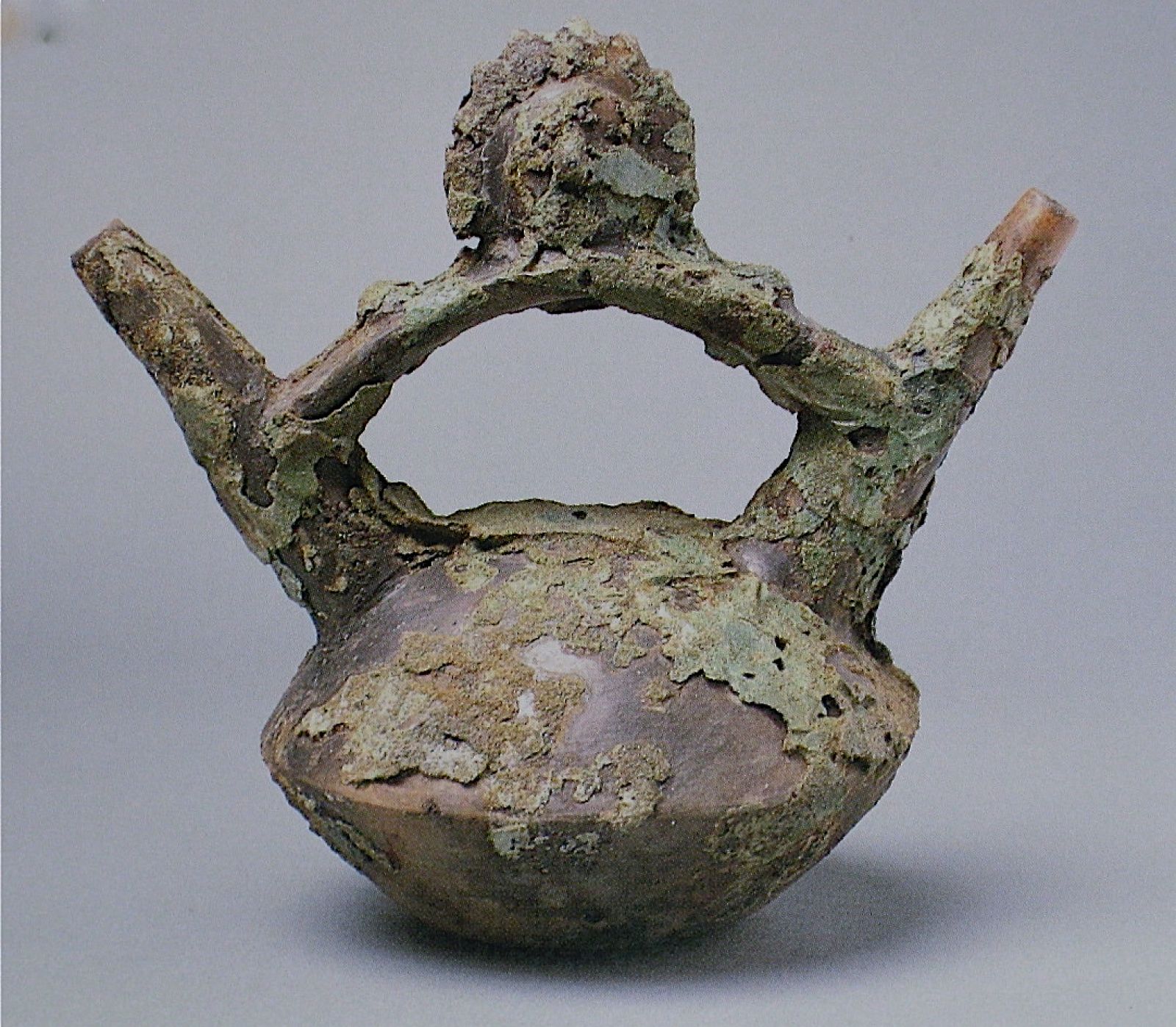
Middle Sicán sheetmetal-covered black ceramic bottle (photo by Yutaka Yoshii).
15 febbraio 2023, ore 17:00
The event will take place online.
To participate please register in advance via Zoom: https://zoom.us/meeting/register/tJYoc-2tqDorEt2oZ0QYPIX16An_9EWg8PM6
After registering, you will receive a confirmation email containing information about joining the meeting.
Avviso
Questo evento viene documentato fotograficamente e/o attraverso riprese video. Qualora non dovesse essere d’accordo con l’utilizzo di immagini in cui potrebbe essere riconoscibile, da parte del Kunsthistorisches Institut in Florenz a scopo di documentazione degli eventi e di pubbliche relazioni (p.e. social media) la preghiamo gentilmente di comunicarcelo.



